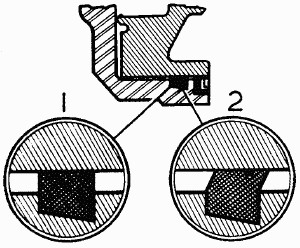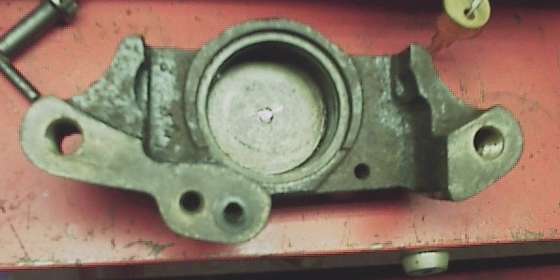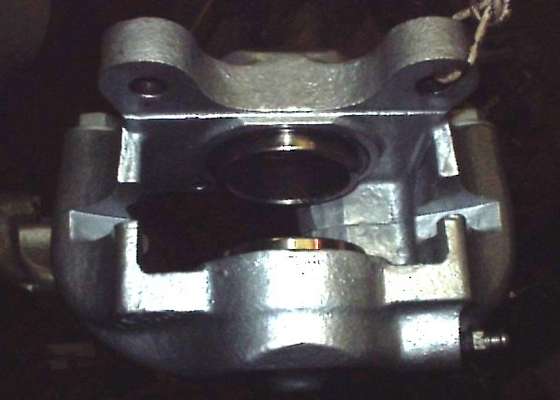The MGA With An Attitude
FUNCTION of a DISC BRAKE CALIPER - BT-104
At 02:47 PM 12/11/04 -0700, Randi C. Lee with a MGA Twin Cam wrote:
>".... we put kits lines are good new pads cylinders are functioning BUT right hand side hangs up and stays hung up ..do you think we need to sleeve that side? ...."
If it was a MGA 1600 I would say no. You should never need to sleeve a brake caliper. The smooth moving seal surface is on the OD of the piston, so if it gets worn or corroded you just replace the piston along with installing new seals. If the caliper bore was worn or corroded you could sand blast it to clean it up, install a new piston and seals, and it's good to go.
However, the Twin Cam caliper has the seal incorporated into the moving piston, and the cylinder wall is smooth. In this case if the bore is pitted it would have to be sleeved. While roughness of the piston (or bore) may cause a leak, it is not usually the cause of a piston hanging up.
When a brake drags on one front wheel, the first suspect is an old deteriorated flex hose. There may be other causes. Please read Diagnosing dragging brakes.

As the piston moves outwards from its static position (1) the fluid seal is deflected (2). When the hydraulic pressure is released the fluid seal regains its static position, moving the piston back and providing clearance at the friction pads.
|
If relieving the hydraulic pressure at the caliper does not stop the drag, then the problem is with a piston hanging up inside the caliper. The caliper may drag when the seals get old and lose their flexibility, or if the outer dust seal fails and allows water or dirt to enter the area between the piston and the cylinder wall. Cure for these problems is to rebuild the caliper with new seals, and maybe replace a piston if it's corroded, or hone the cylinder (1600 model), or sleeve the cylinder for the Twin Cam caliper.
You may notice there are return springs on the shoes of drum brakes, but not on disk brake pads. The MGA 1600 (and the Twin Cam) has a small return spring and bushing arrangement built into the piston which grips on a central guide pin in the caliper. This not only provides for a small return motion, but is (was) also intended to restrict unlimited return travel of the piston. As it turns out neither of these functions are required, because the piston seal does both quite well. The MGB calipers do not have the guide pin or spring in the pistons. Most other cars of the world also do not have or need a return spring or guide bushing on the calipers. This is not actually needed on the MGA either. When rebuilding calipers on the MGA 1600, if new pistons are needed you can remove the center guide pin and use the cheaper pistons from the MGB.
To remove the center pin, remove the big bolts to split the caliper. Holding the caliper half in a vice, grab the center pin with a locking pliers (ViceGrip) and pull hard. Use a pry bar on the ViceGrip if necessary, but do not damage the cylinder lip edge. If the pin does not come out that way you can cut it off flush with bottom of bore using an abrasive cut off wheel in a hand grinder (Dremel tool). A small scratch in the cylinder bore is of no consequence, as the OD of the piston is the sealing surface.

Split caliper half with center pin cut off

Caliper reassembled
For reassembly of the caliper halves, use a new rubber seal washer and apply thread lock adhesive to the bolts. In some cases the old seal washer can be re-used successfully, but you may not know if it works until it's back on the car under pressure.
There is a nice reason why return springs are not needed on disk brake calipers. The internal seal is a square section o-ring held in a groove in the caliper bore. Hydraulic pressure seal is affected against the smooth OD of the piston for the 1600, or against the cylinder bore for the Twin Cam. As the piston moves forward to apply the brakes, the rubber seal drags a bit on the mating surface because of friction. The rubber seal is a bit flexible and springs a little to deform slightly, being pulled along by the movement of the piston. When the hydraulic pressure is released, the rubber seal springs back and pulls the piston back a little bit along with it. This provides just enough return motion to give a thin air film space in front of the friction pad so it will not drag on the rotating disk.
Problem comes when the rubber seal loses the flexibility as it ages and goes hard. When the piston seal is no longer flexible it will not provide the proper return motion for the piston, and the brakes drag, and the pads wear faster. The cure for this is to repack the calipers to install new rubber seals. Notice that the only return force for the piston comes from the flexibility of the rubber seal. This is why it is very important that there should not be any restriction in the hydraulic line, such as a deteriorated hose. The piston also has to move freely in the bore (exclusive of the seal function) for this to work.
|


